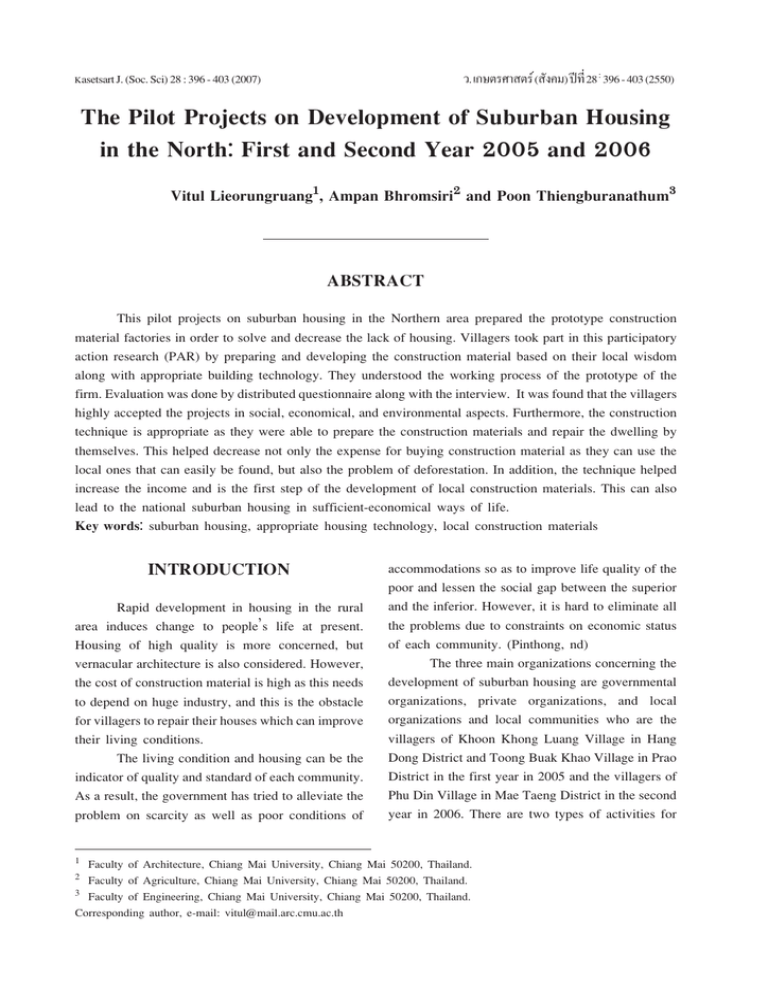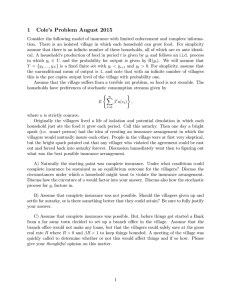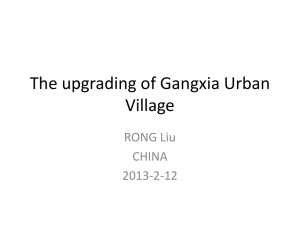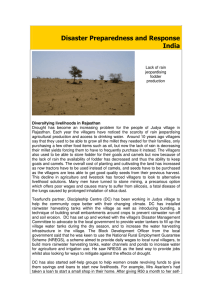The Pilot Projects on Development of Suburban Housing in the North
advertisement

«. ‡°…µ√»“ µ√å ( —ߧ¡) ªï∑’Ë 28 : 396 - 403 (2550) Kasetsart J. (Soc. Sci) 28 : 396 - 403 (2007) The Pilot Projects on Development of Suburban Housing in the North: First and Second Year 2005 and 2006 Vitul Lieorungruang1, Ampan Bhromsiri2 and Poon Thiengburanathum3 ABSTRACT This pilot projects on suburban housing in the Northern area prepared the prototype construction material factories in order to solve and decrease the lack of housing. Villagers took part in this participatory action research (PAR) by preparing and developing the construction material based on their local wisdom along with appropriate building technology. They understood the working process of the prototype of the firm. Evaluation was done by distributed questionnaire along with the interview. It was found that the villagers highly accepted the projects in social, economical, and environmental aspects. Furthermore, the construction technique is appropriate as they were able to prepare the construction materials and repair the dwelling by themselves. This helped decrease not only the expense for buying construction material as they can use the local ones that can easily be found, but also the problem of deforestation. In addition, the technique helped increase the income and is the first step of the development of local construction materials. This can also lead to the national suburban housing in sufficient-economical ways of life. Key words: suburban housing, appropriate housing technology, local construction materials INTRODUCTION Rapid development in housing in the rural area induces change to peopleûs life at present. Housing of high quality is more concerned, but vernacular architecture is also considered. However, the cost of construction material is high as this needs to depend on huge industry, and this is the obstacle for villagers to repair their houses which can improve their living conditions. The living condition and housing can be the indicator of quality and standard of each community. As a result, the government has tried to alleviate the problem on scarcity as well as poor conditions of 1 2 3 accommodations so as to improve life quality of the poor and lessen the social gap between the superior and the inferior. However, it is hard to eliminate all the problems due to constraints on economic status of each community. (Pinthong, nd) The three main organizations concerning the development of suburban housing are governmental organizations, private organizations, and local organizations and local communities who are the villagers of Khoon Khong Luang Village in Hang Dong District and Toong Buak Khao Village in Prao District in the first year in 2005 and the villagers of Phu Din Village in Mae Taeng District in the second year in 2006. There are two types of activities for Faculty of Architecture, Chiang Mai University, Chiang Mai 50200, Thailand. Faculty of Agriculture, Chiang Mai University, Chiang Mai 50200, Thailand. Faculty of Engineering, Chiang Mai University, Chiang Mai 50200, Thailand. Corresponding author, e-mail: vitul@mail.arc.cmu.ac.th «. ‡°…µ√»“ µ√å ( —ߧ¡) ªï∑’Ë 28 ©∫—∫∑’Ë 3 suburban housing development: activities for the unsettlement group and those for the settlement one. From the site surveys, activities to improve and solve the problems on both physical aspects and quality of life which can be concluded are as follows: 1. Problems on physical aspects 1) Lack of knowledge in construction, change, and improvement of accommodation, as well as inability to adapt or use local construction material 2) Lack of standard suburban housing and accommodation 3) Lack of basic needs and commonwealth 4) Lack of public space for activities 5) Lack of stability in land ownership and living 6) Lack of water sources for consumption and use 7) Risk of natural catastrophe in the area where accommodations are located on 2. Problems on life quality (social and environmental aspects) 1) Lack of cooperation among villagers in the community 2) Lack of education 3) Lack of jobs and income 4) Lack of activities that can support living conditions 5) Bad health and living conditions 6) Lack of furtherance of customs and traditions 7) Lack of community management and administration 3. Problems on cooperation among organizations and community The evaluation of suburban housing solution was done by considering criteria on basic information of the village and basic needs of people, set by the committee under the Department of Community Development, Ministry of Interior. Villages can be divided into three groups as follows: 397 1) Self-sufficient suburban village 2) Lack-of-opportunity suburban village 3) Devastated suburban village Even though the conditions of each community are different, depending on its surroundings, there are the same main factors of each suburban village. These are psycho-cultural, territorial, and social organization unit. In addition, at present, suburban village tends to become more urbanized, and this directly affects their socio-cultural aspects (Ankulyudhathon, 2005). Thus, to develop the suburbs, it is necessary to consider every factor that relates to their society, culture, and environment. The National Housing Authority has paid attention to the importance of housing development in both urban and suburban areas. For the suburbs, local wisdom and ways of life, along with traditions and typical characteristics of each village are the main focus in order to retain the unique and charming aspects of village. Moreover, the local community can live their lives in self-sufficient way (Thiengburanathum et al., 2005). As a result, the National Housing Authority supports research on suburban housing so as to be beneficial for the villagers. Chiang Mai University has been supported to do research on development of construction materials by scrap of weeds since the fiscal year 2005. The study has been successful in creating fiber cement board whose raw material can easily be found. Furthermore, villagers can prepare the materials by themselves and are satisfied with the look and the convenience in maintenance. The study then lead to the second phase when the result of the previous study was applied for the target villages where natural fiber can be found, along with other suitable factors, such as conditions of villages and peopleûs ways of life. From the development of the previous study, villagers can make use of the local plants as the construction material. This not only helps them decrease the cost of construction material, but also increases their income by preparing and selling the construction material from scrap of weeds which once was burnt and useless. The technique 398 «. ‡°…µ√»“ µ√å ( —ߧ¡) ªï∑’Ë 28 ©∫—∫∑’Ë 3 decreases the pollution and deforestation as they need not cut trees for their construction material like they used to do in the past. These pilot projects directly respond to villagersû need of accommodations which can be potential and developed for social, economic, and environmental use, and, moreover, the study result can lead to the national level, like the village fund or community bank, as this can be the indicator that villagers are ready for setting the factory, preparing staff for the practice, controlling the standard of construction material, analyzing the cost and expenses, investing the local material and equipments, and planning proper material. The effective researches can lead to further projects which can be applicable for nationally sustainable housing. GOALS & OBJECTIVES The present phase of study has the following goals and objectives: 1. To study and develop suburban housing in construction and change of accommodation styles using local construction material from natural fiber 2. To study and develop the suburban housing which can improve villagersû life quality, stimulate cooperation, and widen their appropriate technology 3. To support activities that sustain villagersû ways of life, works, and increase their income by preparing the prototype of the factory to produce construction material by their local wisdom 4. To prepare and broaden the study results in social, economic, and environmental aspects to the national level RESEARCH METHODOLOGY The research methodology of this study is as follows: 1. Select the target villages which are the rural self-sufficient villages and lack-of-opportunity villages whose villagers are farmers and needed to repair their accommodations. 2. Survey the villagesû background information concerning agriculture, economy, society, vernacular architecture, types of accommodation and construction material, problems, and sources of material to analyze villagersû living conditions, traditions, and the need and cost of construction materials that they had to pay. 3. Select 100 villagers of each village to participate in this participatory action research (PAR) so that they can apply new knowledge to their local wisdom. 4. Prepare and produce the construction materials which are walls and Torchis walls from fiber cement and scrap of weeds. - Prepare the raw construction material from natural fiber that villagers harvested. - Produce the construction material and educate villagers how to adapt new technology to production process in the prototype of the construction material factory. - Repair villagersû accommodations by the prepared construction material in forms of walls and Torchis walls. 5. Survey villagersû opinions towards the project, by using the questionnaire, interview, and public hearings. RESULTS First year results In the first year, the opinion from satisfaction survey in Khoon Khong Luang Village and Toong Buak Khao Village found that the research was successful. The participants of each village are (1) the farmers who played roles in harvesting and processing agricultural material, (2) the workers who played roles in designing, molding, processing, and testing the material, and (3) the villagers and schools who played roles in repairing 11-13 buildings in their villages. It was found that the villagers highly accepted the materials provided by the project, because of suitability in its price, comfort, and «. ‡°…µ√»“ µ√å ( —ߧ¡) ªï∑’Ë 28 ©∫—∫∑’Ë 3 construction technology. In addition, this could reduce pollution from burning scrap of weeds. This also caused the cooperation among villagers and increased their income. Moreover, the heads of the two villages agreed to continue producing their local construction material, but needed the budget to promote this as their OTOP product in the future. For the participants, they were highly satisfied with the production process and duration, including the possibility and potential in producing the material by themselves. However, there was difficulty in production process as it needs skills. They, moreover, gave opinion and advice about setting the factory. Villagers who got help from the project were highly satisfied with the construction material as it looks good and is compatible with their vernacular architecture. However, they were moderately satisfied with the cost of material and gave some opinions and advice about other forms of construction material and wanted the walls produced by this project to be similar to what are generally sold in markets. 399 In addition, interview and data analysis were done to find percentage and correlation among variations. It was found that age, education level, social status, family income, training experience and contact with the staff of the project were directly related to level of participation in the project. Villagers were satisfied with the cost, suitability for their accommodations, and construction skills. (Table 1 -4) However, they moderately accepted this project in human response aspect. For community participation, it was found that villagers who were satisfied with this project were those who needed to repair their accommodations. They found that their local construction material was cheaper, able to repair their accommodations, and could decrease deforestation which brings them better life quality and environment. Furthermore, the activity had potential in increasing their income as it can be their OTOP product. This can finally lead the villages to self-sufficient community with sustainable development and environmental conservation (Lieorungruang et al., 2005). Table 1 Satisfaction levels in production of construction materials at Khoon Khong Luang village. Topic Satisfaction level Most High Moderate Little Least 1. Production period 82% 18% 2. Difficulty in production process 100% 3. Preparation process 100% 4. Manufacturing skills 100% 5. Possibility in processing by the 100% villagers themselves Table 2 Satisfaction levels in production of construction materials at Toong Buak Khao village. Topic Satisfaction level Most High Moderate Little Least 1. Production period 78% 22% 2. Difficulty in production process 100% 3. Preparation process 100% 4. Manufacturing skills 100% 5. Possibility in processing by the villagers themselves 100% 400 «. ‡°…µ√»“ µ√å ( —ߧ¡) ªï∑’Ë 28 ©∫—∫∑’Ë 3 Table 3 Satisfaction levels in types of construction materials at Khoon Khong Luang village. Topic Satisfaction level Most High Moderate Little Least 1. Appearance and texture 100% 2. Difficulty in construction skills 19% 81% 3. Cost 89% 11% 4. Suitability for their accommodations 89% 11% Table 4 Satisfaction levels in types of construction materials at Toong Buak Khao village. Topic Satisfaction level Most High Moderate Little 1. Appearance and texture 100% 2. Difficulty in construction skills 30% 70% 3. Cost 90% 10% 4. Suitability for their accommodations 90% 10% Second year results In the second year, the project also prepared the prototype of the factory for construction material and chose 20 houses at the ninth village of Phu Din in Mae Hor Phra Subdistrict, Mae Tang District, Chiang Mai Province. This continuously followed the previous project initiated in the previous year aiming to solve the problem of accommodation lacking. Apparently, change and development of accommodation were observed on using of construction material that can be found in the local area. Villagers can play roles in this participatory action research (PAR) by blending their local wisdom along with appropriate construction technology. They can, moreover, understand the working process of the prototype of the factory. Evaluation was done by distributed questionnaire along with the interview, and it was found that the villagers highly accepted this project in social, economical, and environmental aspects. The construction technique is appropriate as the villagers can prepare the construction material and repair the dwelling by themselves. This process can also help decrease not only the expense for buying construction material, but also the extent of deforestation. In addition, the process can help increase income and is the first step for development Least of local construction materials. This can also lead to the national suburban housing scheme in line with sufficient-economical ways of life (http:// www.thaitambon.com) ADVANTAGES GAINED FROM THE RESEARCH Implications from this projects are as follows: 1. Guidelines are established for suburban housing, in physical aspect and life quality which are community cooperation process, learning process, satisfaction and equality in community. Other results include career support, living support, income from local construction material from scrap of weeds, and construction of the prototype of the factory. Villagers not only gain much more income, but also live their lives in self-sufficient way which goes well with their local wisdom. 2. There are plans for suburban housing projects and annual plans for villagers which are compatible with agricultural ways of life. 3. Plans are proposed for the prototype of the factory for local constructed materials and process of constructing natural fiber cement board. 401 «. ‡°…µ√»“ µ√å ( —ߧ¡) ªï∑’Ë 28 ©∫—∫∑’Ë 3 Table 5 Opinions from villagers on advantages of using local materials for the construction materials at Phu Din village. Advantages Percentage Board of the Village Villagers 1. Solving accommodation lacking 67% 84% 2. Decreasing deforestation 67% 76% 3. Giving opportunities to the inferior 67% 84% 4. Decreasing environmental problems 100% 76% 5. Increasing local income 67% 81% 6. Educating local villagers 83% 67% Table 6 Opinions from villagers on suitability of manufacturing fiber cement at Phu Din village. Suitability Percentage 1. Convenience in installation 62% 2. Appearance and texture 92% 3. Comfortable living 92% 4. Compatibility with their culture 92% Table 7 Satisfaction on fiber cement factory at Phu Din village. Suitability 1. Cooperation of villagers during limited time 2. Cooperation of villagers during harvesting time 3. Circulation of workforce 4. Cooperation of villagers to work at night when necessary For the project in the second yeae, each natural fiber cement board costs 52.671 baht, comprising the cost of raw material, cost of labor, and expenses of construction. It takes two years and three months for the Break Even Point. To calculate without considering the profit, it takes three years and two months for the Break Even Point. For the cost of the factory, as there is one building in Phu Din Village which is 99,774 baht, it needed just the addition to the building which costs 99,332.04 baht, with 98,905.99 baht for the construction material of the factory. In average, the prototype of the factory can produce 1,420 pieces of natural fiber cement board at a time which costs 74,791.40 baht. There are 20 houses participated and needed help from this project, and Percentage 84.6% 69.2% 92% 78.9% this costs 192,230.04 baht. Each house got 60 pieces of natural fiber cement board, 80-meter wood frames, wages and equipments for repairing, as well as the budget for miscellaneous items which totally cost 11,307.66 baht per each house. 4. Guidelines are derived for educating villagers on how to adapt technology to the working process. Along with the guidelines are working manual for prototype of the factory, and working manual for selecting raw construction material, molding, and setting the natural fiber cement board, as well as model and process of preparing natural fiber cement board, list of equipments for preparing natural fiber cement board, process of preparing the wood or iron structure, process of molding, process 402 «. ‡°…µ√»“ µ√å ( —ߧ¡) ªï∑’Ë 28 ©∫—∫∑’Ë 3 of repairing natural fiber cement board, and process of decorating the surface of natural fiber cement board. 5. Management system is formed for the three organizations relating to the projects which are the National Housing Authority, Chiang Mai University, and the villagers, along with the provided fund, production technology, Community Corporation, groups to run the sustainable prototype of the factory for local construction material, and the budget management under government support. 6. Sustainable development approach was put into practice for sufficient-economical ways of life, along with the strategic structure to further the work of suburban housing projects, as follows: - A framework of the suburban housing projects was set by the National Housing Authority in order to solve the poverty and lack of accommodations. - A workshop was initiated to test and develop the potential of villages. - Development of working manuals which cover every important aspect and factor was prepared. - A seminar and pieces of advice were open to public for running following suburban housing projects in the future. - Connection among universities and academic institutes was formed to help strengthen the villagers and their local wisdom as these institutes are one main factor to further the following suburban housing projects. - Preparation to further the potential of all self-sufficient villages was concluded, comprising 68,501 villages in 6,943 sub-districts of 76 provinces. - Studies and researches were done to develop the construction material for suburban housing projects. Figure 1, 2, 3 Villagers and their roles in the prototype of the factory for local construction material. Figure 4, 5 Exterior and interior walls from natural fiber cement boards. «. ‡°…µ√»“ µ√å ( —ߧ¡) ªï∑’Ë 28 ©∫—∫∑’Ë 3 403 LITERATURE CITED Figure 6 Repairing process from scrap of weeds to a new house. Ankulyudhathon, E. 2005. Report on Possibility Study for Work Plan of Suburban Housing Development. Bangkok: Kasetsart University. Lieorungruang, V., P. Thiengburanathum and A. Bhromsiri. 2005. Report on the Pilot Projects on Suburban Housing in the North. Chiang Mai: Chiang Mai University. Pinthong, J. nd. çPublic Assembly for Suburban Developmenté. Sethasart Parithat Journal, Chulalongkorn University 47(4): 94-102. Thiengburanathum, P., V. Lieorungruang and A. Bhromsiri. 2005. Report on Research Projects on Local Housing for Self-Reliance. Chiang Mai: Chiang Mai University. The Executive Office of Mae Hor Phra Subdistrict, Mae Taeng District, Chiang Mai Province. available at URL: http://www.thaitambon.com




